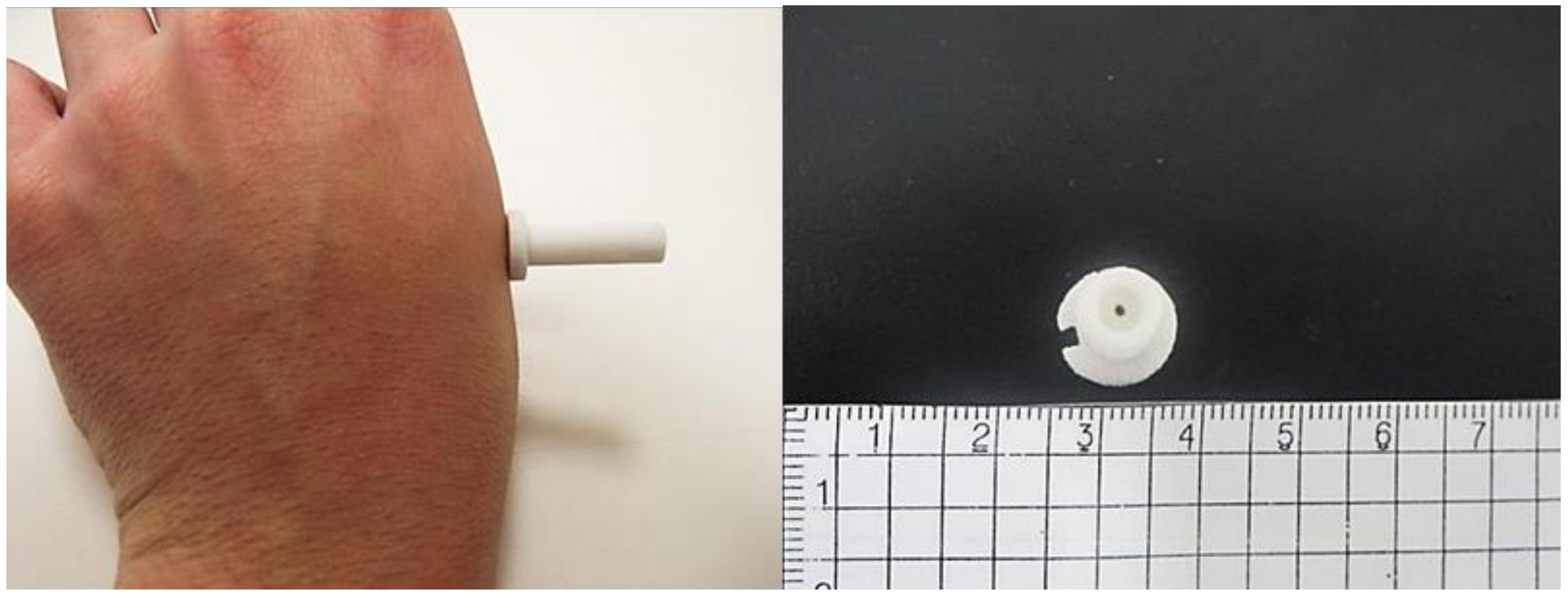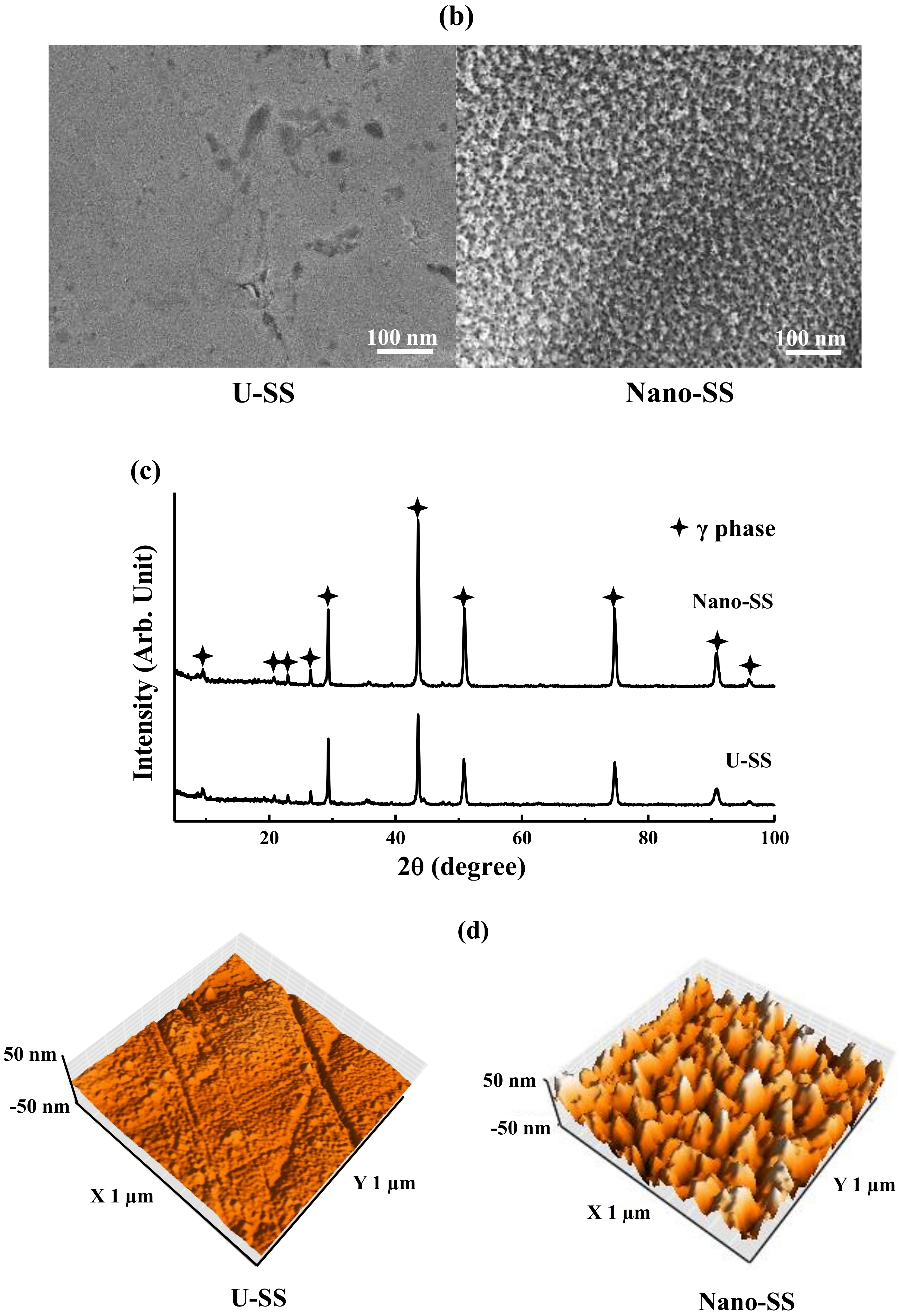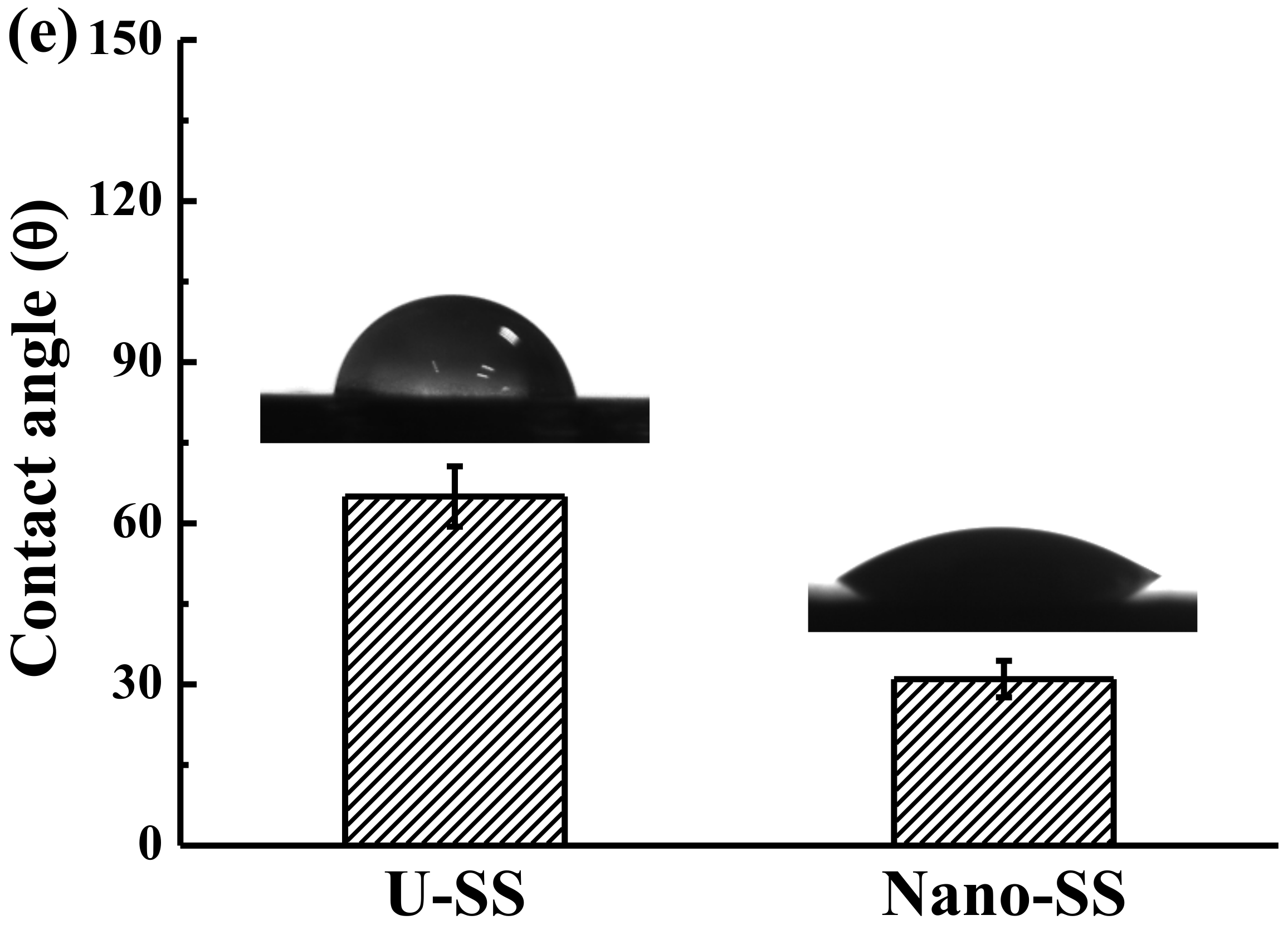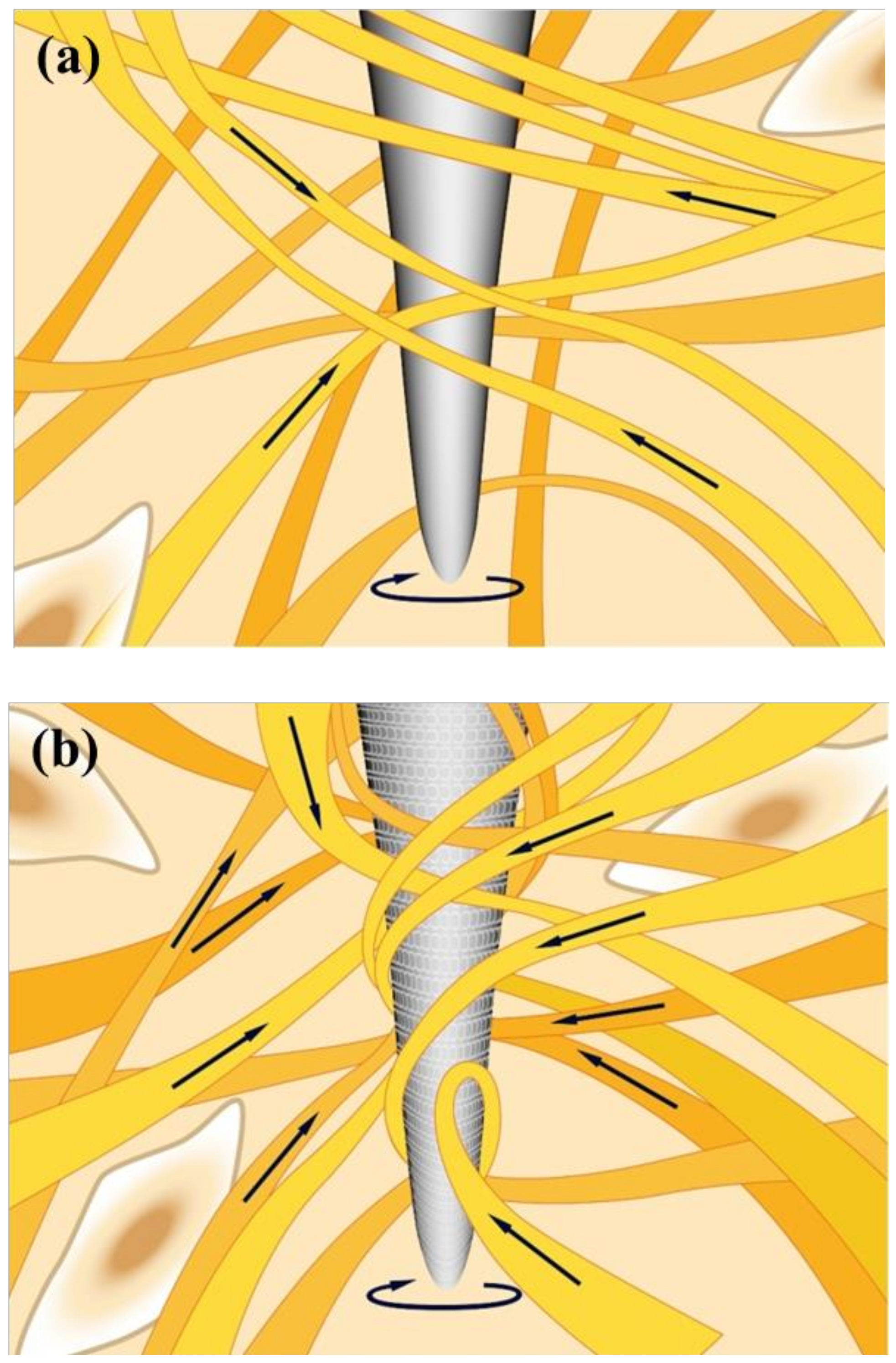The Potential of Nano-Porous Surface Structure for Pain Therapeutic Applications: Surface Properties and Evaluation of Pain Perception
Abstract
Featured Application
Abstract
1. Introduction
2. Materials and Methods
2.1. Materials Preparation
2.2. Surface Property Evaluation of the Modified Needle Samples
2.3. Finite Element Analysis (FEA)
2.4. Participants
2.5. Study Design
2.6. Acupuncture
2.7. PPT
2.8. Statistics
3. Results
3.1. Nano-Modified Surface Properties
3.2. Effect of Nano-Modified Surface Acupuncture on Human Pressure Pain Sensitivity
4. Discussion
5. Conclusions
Author Contributions
Funding
Conflicts of Interest
References
- List, T.; Axelsson, S. Management of TMD: Evidence from systematic reviews and meta-analyses. J. Oral Rehabil. 2010, 37, 430–451. [Google Scholar] [CrossRef] [PubMed]
- Vase, L.; Baram, S.; Takakura, N.; Yajima, H.; Takayama, M.; Kaptchuk, T.J.; Schou, S.; Jensen, T.S.; Zachariae, R.; Svensson, P. Specifying the nonspecific components of acupuncture analgesia. Pain 2013, 154, 1659–1667. [Google Scholar] [CrossRef] [PubMed]
- Welsh, D.; Hengerer, A.S. The diagnosis and treatment of intramuscular hemangiomas of the masseter muscle. Am. J. Otolaryngol. 1980, 1, 186–190. [Google Scholar] [CrossRef]
- Lao, L. Acupuncture techniques and devices. J. Altern. Complement. Med. 1996, 2, 23–25. [Google Scholar] [CrossRef]
- Mupparapu, M. Evidence Based Approach for the Diagnosis of Temporomandibular Joint Disorders (TMD). J. Indian Prosthodont. Soc. 2013, 13, 387–388. [Google Scholar] [CrossRef]
- Ott, K.H. Diagnosis and therapy of masseter hypertrophy. HNO 1983, 31, 207–211. [Google Scholar] [PubMed]
- Cheng, H.Y.; Peng, P.W.; Lin, Y.J.; Chang, S.T.; Pan, Y.N.; Lee, S.C.; Ou, K.L.; Hsu, W.C. Stress analysis during jaw movement based on vivo computed tomography images from patients with temporomandibular disorders. Int. J. Oral Maxillofac. Surg. 2013, 42, 386–392. [Google Scholar] [CrossRef] [PubMed]
- Kurita, K.; Westesson, P.-L.; Yuasa, H.; Toyama, M.; Machida, J.; Ogi, N. Natural Course of Untreated Symptomatic Temporomandibular Joint Disc Displacement without Reduction. J. Dent. Res. 1998, 77, 361–365. [Google Scholar] [CrossRef] [PubMed]
- Kalpakci, K.N.; Willard, V.P.; Wong, M.E.; Athanasiou, K.A. An Interspecies Comparison of the Temporomandibular Joint Disc. J. Dent. Res. 2011, 90, 193–198. [Google Scholar] [CrossRef] [PubMed]
- Pereira, L.J.; Steenks, M.H.; de Wijer, A.; Speksnijder, C.M.; van der Bilt, A. Masticatory function in subacute TMD patients before and after treatment. J. Oral Rehabil. 2009, 36, 391–402. [Google Scholar] [CrossRef]
- Durham, J.; Steele, J.; Moufti, M.A.; Wassell, R.; Robinson, P.; Exley, C. Temporomandibular disorder patients’ journey through care. Community Dent. Oral 2011, 39, 532–541. [Google Scholar] [CrossRef] [PubMed]
- Kou, W.; Gareus, I.; Bell, J.D.; Goebel, M.U.; Spahn, G.; Pacheco-Lopez, G.; Backer, M.; Schedlowski, M.; Dobos, G.J. Quantification of DeQi sensation by visual analog scales in healthy humans after immunostimulating acupuncture treatment. Am. J. Chin. Med. 2007, 35, 753–765. [Google Scholar] [CrossRef] [PubMed]
- Liang, Z.H.; Xie, C.C.; Li, Z.P.; Zhu, X.P.; Lu, A.P.; Fu, W.B. Deqi sensation in placebo acupuncture: A crossover study on Chinese medicine students. Evid. Based Complement. Altern. Med. 2013, 2013, 620671. [Google Scholar] [CrossRef] [PubMed]
- Zhang, S.; Mu, W.; Xiao, L.; Zheng, W.K.; Liu, C.X.; Zhang, L.; Shang, H.C. Is deqi an indicator of clinical efficacy of acupuncture? A systematic review. Evid. Based Complement. Altern. Med. 2013, 2013, 750140. [Google Scholar] [CrossRef]
- Park, J.; Park, H.; Lee, H.; Lim, S.; Ahn, K.; Lee, H. Deqi sensation between the acupuncture-experienced and the naive: A Korean study II. Am. J. Chin. Med. 2005, 33, 329–337. [Google Scholar] [CrossRef]
- Yang, X.Y.; Shi, G.X.; Li, Q.Q.; Zhang, Z.H.; Xu, Q.; Liu, C.Z. Characterization of deqi sensation and acupuncture effect. Evid. Based Complement. Altern. Med. 2013, 2013, 319734. [Google Scholar] [CrossRef] [PubMed]
- Langevin, H.M.; Churchill, D.L.; Wu, J.; Badger, G.J.; Yandow, J.A.; Fox, J.R.; Krag, M.H. Evidence of connective tissue involvement in acupuncture. FASEB J. 2002, 16, 872–874. [Google Scholar] [CrossRef]
- Langevin, H.M.; Storch, K.N.; Snapp, R.R.; Bouffard, N.A.; Badger, G.J.; Howe, A.K.; Taatjes, D.J. Tissue stretch induces nuclear remodeling in connective tissue fibroblasts. Histochem. Cell Biol. 2010, 133, 405–415. [Google Scholar] [CrossRef]
- Langevin, H.M. Connective tissue: A body-wide signaling network? Med. Hypotheses 2006, 66, 1074–1077. [Google Scholar] [CrossRef]
- Langevin, H.M.; Churchill, D.L.; Cipolla, M.J. Mechanical signaling through connective tissue: A mechanism for the therapeutic effect of acupuncture. FASEB J. 2001, 15, 2275–2282. [Google Scholar] [CrossRef]
- Langevin, H.M.; Bouffard, N.A.; Fox, J.R.; Palmer, B.M.; Wu, J.; Iatridis, J.C.; Barnes, W.D.; Badger, G.J.; Howe, A.K. Fibroblast cytoskeletal remodeling contributes to connective tissue tension. J. Cell Physiol. 2011, 226, 1166–1175. [Google Scholar] [CrossRef] [PubMed]
- Joshi, N.; Araque, H. Neurophysiologic basis for the relief of human pain by acupuncture. Acupunct. Electrother. Res. 2009, 34, 165–174. [Google Scholar] [CrossRef] [PubMed]
- Hui, K.K.; Nixon, E.E.; Vangel, M.G.; Liu, J.; Marina, O.; Napadow, V.; Hodge, S.M.; Rosen, B.R.; Makris, N.; Kennedy, D.N. Characterization of the “deqi” response in acupuncture. BMC Complement. Altern Med. 2007, 7, 33. [Google Scholar] [CrossRef] [PubMed]
- Yim, E.K.; Darling, E.M.; Kulangara, K.; Guilak, F.; Leong, K.W. Nanotopography-induced changes in focal adhesions, cytoskeletal organization, and mechanical properties of human mesenchymal stem cells. Biomaterials 2010, 31, 1299–1306. [Google Scholar] [CrossRef]
- Liu, X. Correlation analysis of surface topography and its mechanical properties at micro and nanometre scales. Wear 2013, 305, 305–311. [Google Scholar] [CrossRef]
- Arsiwala, A.; Desai, P.; Patravale, V. Recent advances in micro/nanoscale biomedical implants. J. Controll. Release 2014, 189, 25–45. [Google Scholar] [CrossRef]
- Saber, O.; Hefny, N.; al Jaafari, A.A. Improvement of physical characteristics of petroleum waxes by using nano-structured materials. Fuel Process. Technol. 2011, 92, 946–951. [Google Scholar] [CrossRef]
- Martinez, E.; Engel, E.; Planell, J.A.; Samitier, J. Effects of artificial micro- and nano-structured surfaces on cell behavior. Ann. Anat. Anat. Anz. 2009, 191, 126–135. [Google Scholar] [CrossRef] [PubMed]
- Andersson, A.S.; Backhed, F.; von Euler, A.; Richter-Dahlfors, A.; Sutherland, D.; Kasemo, B. Nanoscale features influence epithelial cell morphology and cytokine production. Biomaterials 2003, 24, 3427–3436. [Google Scholar] [CrossRef]
- Dalby, M.J.; McCloy, D.; Robertson, M.; Agheli, H.; Sutherland, D.; Affrossman, S.; Oreffo, R.O.C. Osteoprogenitor response to semi-ordered and random nanotopographies. Biomaterials 2006, 27, 2980–2987. [Google Scholar] [CrossRef] [PubMed]
- Dalby, M.J.; Gadegaard, N.; Tare, R.; Andar, A.; Riehle, M.O.; Herzyk, P.; Wilkinson, C.D.; Oreffo, R.O. The control of human mesenchymal cell differentiation using nanoscale symmetry and disorder. Nat. Mater. 2007, 6, 997–1003. [Google Scholar] [CrossRef] [PubMed]
- Dalby, M.J.; Gadegaard, N.; Oreffo, R.O. Harnessing nanotopography and integrin-matrix interactions to influence stem cell fate. Nat. Mater. 2014, 13, 558–569. [Google Scholar] [CrossRef] [PubMed]
- Bachmann, J.; Ellies, A.; Hartge, K.H. Development and application of a new sessile drop contact angle method to assess soil water repellency. J. Hydrol. 2000, 231, 66–75. [Google Scholar] [CrossRef]
- Maier, C.; Baron, R.; Tolle, T.R.; Binder, A.; Birbaumer, N.; Birklein, F.; Gierthmuhlen, J.; Flor, H.; Geber, C.; Huge, V.; et al. Quantitative sensory testing in the German Research Network on Neuropathic Pain (DFNS): Somatosensory abnormalities in 1236 patients with different neuropathic pain syndromes. Pain 2010, 150, 439–450. [Google Scholar] [CrossRef]
- Rolke, R.; Baron, R.; Maier, C.; Tolle, T.R.; Treede, R.D.; Beyer, A.; Binder, A.; Birbaumer, N.; Birklein, F.; Botefur, I.C.; et al. Quantitative sensory testing in the German Research Network on Neuropathic Pain (DFNS): Standardized protocol and reference values. Pain 2006, 123, 231–243. [Google Scholar] [CrossRef]
- Pigg, M.; Baad-Hansen, L.; Svensson, P.; Drangsholt, M.; List, T. Reliability of intraoral quantitative sensory testing (QST). Pain 2010, 148, 220–226. [Google Scholar] [CrossRef]
- Drelich, J.; Chibowski, E.; Meng, D.D.; Terpilowski, K. Hydrophilic and superhydrophilic surfaces and materials. Soft Matter 2011, 7, 9804–9828. [Google Scholar] [CrossRef]
- Takeshige, C.; Sato, M. Comparisons of pain relief mechanisms between needling to the muscle, static magnetic field, external qigong and needling to the acupuncture point. Acupunct. Electrother. Res. 1996, 21, 119–131. [Google Scholar] [CrossRef]
- Karst, M.; Rollnik, J.D.; Fink, M.; Reinhard, M.; Piepenbrock, S. Pressure pain threshold and needle acupuncture in chronic tension-type headache--a double-blind placebo-controlled study. Pain 2000, 88, 199–203. [Google Scholar] [CrossRef]
- Orhan, E.K.; Deymeer, F.; Oflazer, P.; Parman, Y.; Baslo, M.B. Jitter analysis with concentric needle electrode in the masseter muscle for the diagnosis of generalised myasthenia gravis. Clin. Neurophysiol. 2013, 124, 2277–2282. [Google Scholar] [CrossRef]
- Itoh, K.; Minakawa, Y.; Kitakoji, H. Effect of acupuncture depth on muscle pain. Chin. Med. 2011, 6, 24. [Google Scholar] [CrossRef] [PubMed]
- Ulett, G.A. Acupuncture treatments for pain relief. JAMA 1981, 245, 768–769. [Google Scholar] [CrossRef] [PubMed]
- Asghar, A.U.; Green, G.; Lythgoe, M.F.; Lewith, G.; MacPherson, H. Acupuncture needling sensation: The neural correlates of deqi using fMRI. Brain Res. 2010, 1315, 111–118. [Google Scholar] [CrossRef] [PubMed]
- Langevin, H.M.; Yandow, J.A. Relationship of acupuncture points and meridians to connective tissue planes. Anat. Rec. 2002, 269, 257–265. [Google Scholar] [CrossRef] [PubMed]
- Langevin, H.M.; Storch, K.N.; Cipolla, M.J.; White, S.L.; Buttolph, T.R.; Taatjes, D.J. Fibroblast spreading induced by connective tissue stretch involves intracellular redistribution of alpha- and beta-actin. Histochem. Cell Biol. 2006, 125, 487–495. [Google Scholar] [CrossRef] [PubMed]
- Eadie, M.J. Acupuncture and the relief of pain. Med. J. Aust. 1990, 153, 180–181. [Google Scholar] [CrossRef]
- Seminowicz, D.A. Acupuncture and the CNS: What can the brain at rest suggest? Pain 2008, 136, 230–231. [Google Scholar] [CrossRef]
- Rong, P.J.; Zhu, B.; Huang, Q.F.; Gao, X.Y.; Ben, H.; Li, Y.H. Acupuncture inhibition on neuronal activity of spinal dorsal horn induced by noxious colorectal distention in rat. World J. Gastroenterol. 2005, 11, 1011–1017. [Google Scholar] [CrossRef]
- Woolf, C.J.; Salter, M.W. Neuronal Plasticity: Increasing the Gain in Pain. Science 2000, 288, 1765–1768. [Google Scholar] [CrossRef] [PubMed]
- Melzack, R. Evolution of the Neuromatrix Theory of Pain. The Prithvi Raj Lecture: Presented at the Third World Congress of World Institute of Pain, Barcelona 2004. Pain Pract. 2005, 5, 85–94. [Google Scholar] [CrossRef]
- Mao, J.J.; Rahemtulla, F.; Scott, P.G. Proteoglycan Expression in the Rat Temporomandibular Joint in Response to Unilateral Bite Raise. J. Dent. Res. 1998, 77, 1520–1528. [Google Scholar] [CrossRef] [PubMed]
- Berkovitz, B.K.B.; Robertshaw, H. Ultrastructural quantification of collagen in the articular disc of the temporomandibular joint of the rabbit. Arch. Oral Biol. 1993, 38, 91–95. [Google Scholar] [CrossRef]
- Liu, M.; Tanswell, A.K.; Post, M. Mechanical force-induced signal transduction in lung cells. Am. J. Physiol. Lung Cell. Mol. Physiol. 1999, 277, L667–L683. [Google Scholar] [CrossRef] [PubMed]
- Cope, F.W. Piezoelectricity and pyroelectricity as a basis for force and temeprature detection by nerve receptors. Bull. Math. Biol. 1973, 35, 31–41. [Google Scholar] [CrossRef]
- Yamanishi, T.; Yasuda, K. Electrical stimulation for stress incontinence. Int. Urogynecol. J. 1998, 9, 281–290. [Google Scholar] [CrossRef] [PubMed]
- Chiquet, M. Regulation of extracellular matrix gene expression by mechanical stress. Matrix Biol. 1999, 18, 417–426. [Google Scholar] [CrossRef]







| Inactive | Active | |||||||
|---|---|---|---|---|---|---|---|---|
| Site | Baseline | Immediately | 10 min | 20 min | Baseline | Immediately | 10 min | 20 min |
| Dom | 195.1 (74.7) | 175.9 (62.9) | 190.3 (70.4) | 200.7 (72.7) | 203.7 (71.3) | 195.1 (76.8) | 220.9 (88.4) | 204.1 (76.1) |
| Non | 191.4 (77.7) | 179.6 (69.6) | 188.7 (73.0) | 184.3 (73.3) | 196.7 (77.8) | 203.2 (78.3) | 198.7 (81.2) | 204.5 (84.5) |
| Thenar | 294.0 (132.0) | 312.5 (131.4) | 285.5 (136.6) | 286.2 (174.6) | 321.5 (166.8) | 319.9 (160.6) | 320.5 (169.3) | 326.1 (194.7) |
| Total | 226.8 (108.0) | 222.7 (111.9) | 221.5 (106.8) | 223.7 (123.7) | 240.6 (126.1) | 239.4 (124.5) | 246.7 (129.4) | 244.9 (140.5) |
© 2020 by the authors. Licensee MDPI, Basel, Switzerland. This article is an open access article distributed under the terms and conditions of the Creative Commons Attribution (CC BY) license (http://creativecommons.org/licenses/by/4.0/).
Share and Cite
Wu, C.-Z.; Hsu, L.-C.; Chou, H.-H.; Barnkob, S.; Eggert, T.; Nielsen, P.L.; Young, R.; Vase, L.; Wang, K.; Svensson, P.; et al. The Potential of Nano-Porous Surface Structure for Pain Therapeutic Applications: Surface Properties and Evaluation of Pain Perception. Appl. Sci. 2020, 10, 4578. https://doi.org/10.3390/app10134578
Wu C-Z, Hsu L-C, Chou H-H, Barnkob S, Eggert T, Nielsen PL, Young R, Vase L, Wang K, Svensson P, et al. The Potential of Nano-Porous Surface Structure for Pain Therapeutic Applications: Surface Properties and Evaluation of Pain Perception. Applied Sciences. 2020; 10(13):4578. https://doi.org/10.3390/app10134578
Chicago/Turabian StyleWu, Ching-Zong, Ling-Chuan Hsu, Hsin-Hua Chou, Sanne Barnkob, Tobias Eggert, Pernille Lind Nielsen, Roger Young, Lene Vase, Kelun Wang, Peter Svensson, and et al. 2020. "The Potential of Nano-Porous Surface Structure for Pain Therapeutic Applications: Surface Properties and Evaluation of Pain Perception" Applied Sciences 10, no. 13: 4578. https://doi.org/10.3390/app10134578
APA StyleWu, C.-Z., Hsu, L.-C., Chou, H.-H., Barnkob, S., Eggert, T., Nielsen, P. L., Young, R., Vase, L., Wang, K., Svensson, P., Ou, K.-L., & Baad-Hansen, L. (2020). The Potential of Nano-Porous Surface Structure for Pain Therapeutic Applications: Surface Properties and Evaluation of Pain Perception. Applied Sciences, 10(13), 4578. https://doi.org/10.3390/app10134578




